Choosing the right foods can be a major factor in managing diabetes effectively. Seafood emerges as a significant component of a nutritious diet, particularly for those managing blood sugar levels.
The benefits of seafood stem from its rich profile of omega-3 fatty acids, lean protein, vitamins, and minerals, contributing to heart health and overall wellness. It’s important to select varieties that are not only low in unhealthy fats and calories but also provide essential nutrients which can support the unique dietary needs of individuals with diabetes.

Introducing Sugar Defender, an advanced blend of 24 proven ingredients that support healthy glucose levels and natural weight loss.
However, not all seafood is created equal, especially considering the dietary restrictions associated with diabetes.
Understanding which types of seafood are best suited for a diabetic diet and recognizing safe consumption practices can play a vital role in blood sugar control.
In addition to nutritional content, factors such as mercury levels and the presence of omega-3 fatty acids must be taken into account.
With a plethora of options available, from fatty fish like salmon and trout to shellfish, making informed choices can lead to enjoyable and healthy meals for people with diabetes.
Key Takeaways
- Seafood offers essential nutrients beneficial for diabetes management.
- Choices like salmon and trout are particularly advantageous for those with diabetes.
- Safe seafood consumption for diabetics involves considering mercury levels and nutritional value.
Importance of Seafood in a Diabetes Diet
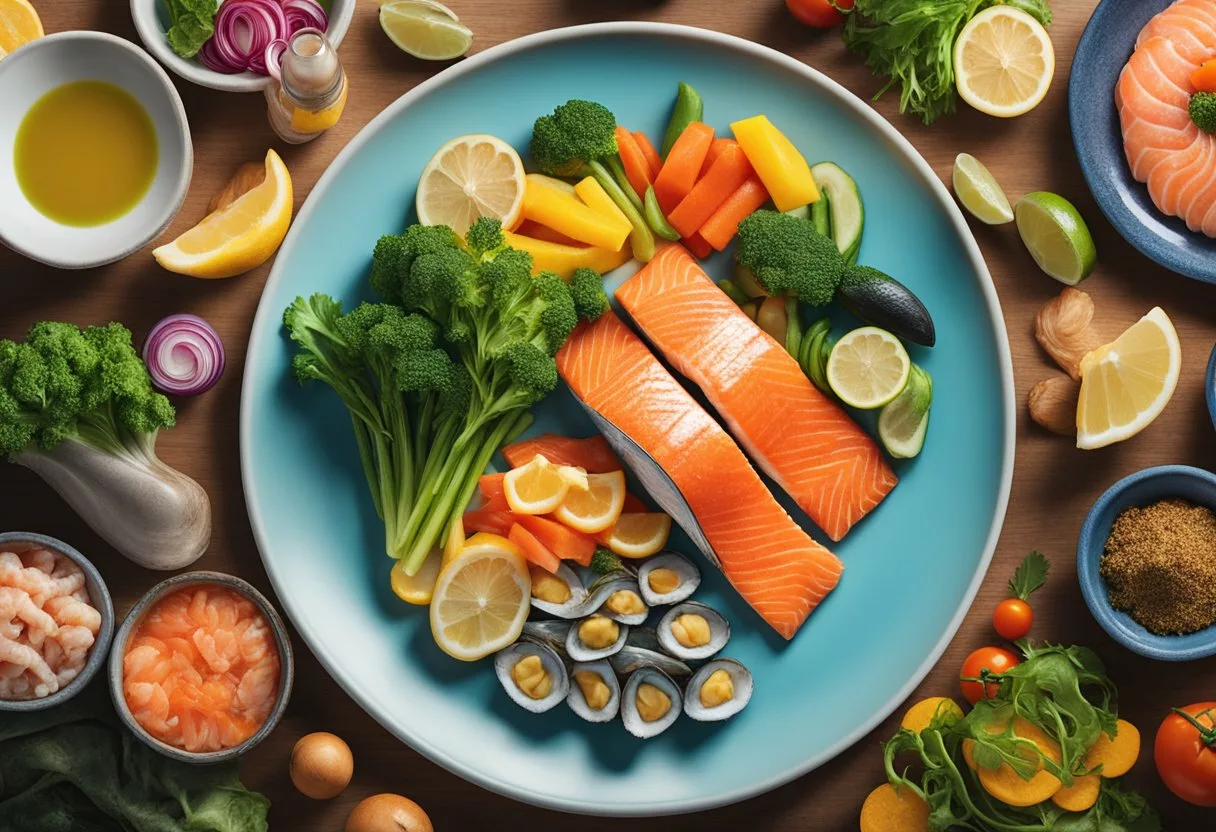
Seafood offers an array of benefits for individuals managing diabetes, from heart health to blood glucose control, due to its high concentration of essential nutrients.
Key Nutrients in Seafood for Diabetes
Seafood is an excellent source of omega-3 fatty acids, specifically EPA and DHA, which are crucial for maintaining heart health and can contribute to the improvement of glucose metabolism.
Rich in quality protein with a low calorie content, seafood may also help with weight management and enhance satiety.
Include options like salmon and mackerel, which have been highlighted by the American Heart Association for their health benefits.
The Role of Seafood in Blood Glucose Control
Eating seafood may help in regulating blood glucose levels.
The high protein content has minimal impact on blood sugar, making it a favorable choice for individuals with type 2 diabetes.
Incorporating seafood into a diet can also improve insulin resistance, thus aiding in the overall management of diabetes.
Seafood’s Impact on Heart Health
Regular consumption of seafood has been associated with a reduced risk of heart attack, stroke, and heart disease.
It contributes positively to altering the levels of HDL and LDL cholesterol, as well as reducing triglycerides, according to studies encouraged by health organizations such as the American Diabetes Association.
Warnings on Seafood Consumption
Although beneficial, it’s important to be aware of mercury levels in certain fish and to follow FDA guidelines to prevent any potential risks.
Pregnant people and young children should avoid fish with high mercury content, and adult individuals with diabetes should opt for seafood known to be low in mercury, such as trout and sardines.
Seafood and Weight Management
Due to its lower calorie count and high levels of protein that promote satiety, seafood can be an integral part of a weight management plan for people with diabetes.
Managing carbs and portion size, while choosing the right kind of seafood, can aid in maintaining a healthy weight, which is paramount in managing type 2 diabetes.
Best Fish for People with Diabetes
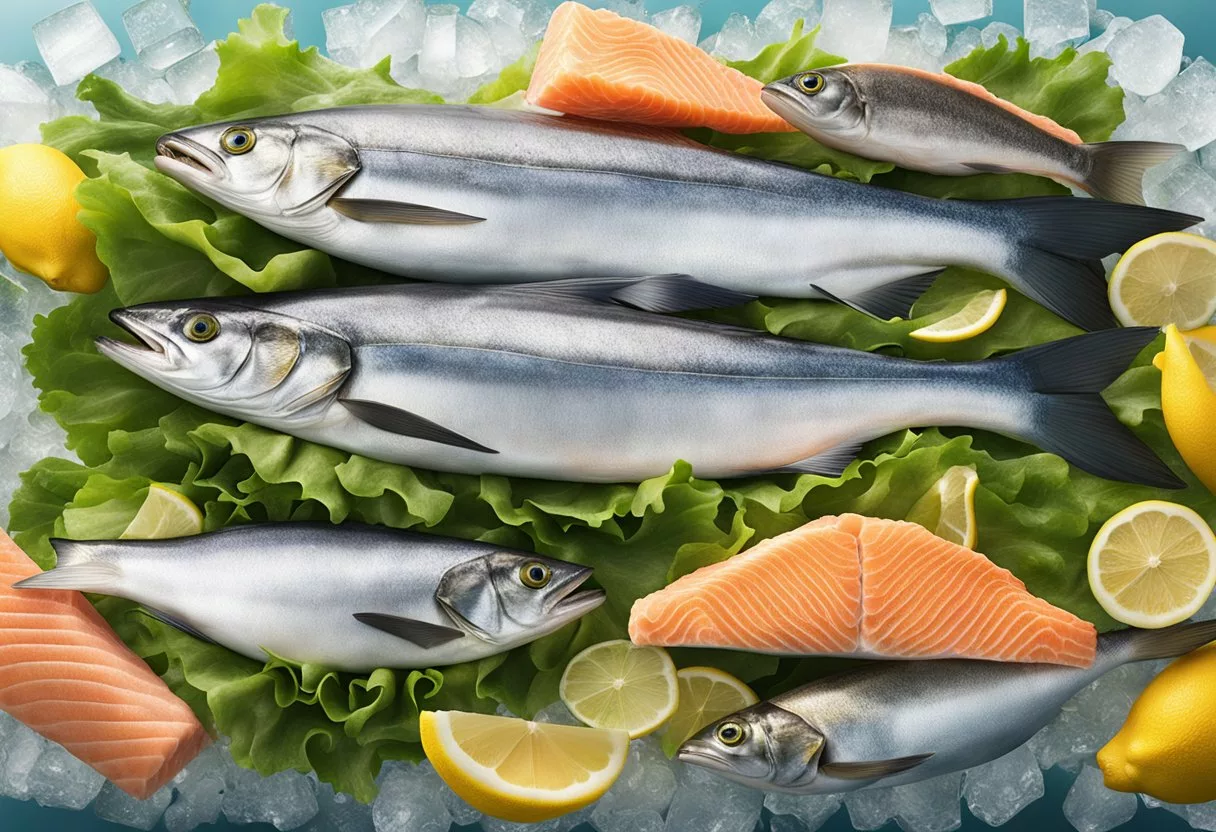
Integrating fish into a diabetic diet is beneficial due to their high content of omega-3 fatty acids, lean protein, and essential nutrients. Select fishes offer distinct advantages for managing diabetes and supporting heart health.
Salmon and Its Benefits
Salmon is a premier choice for people with diabetes due to its abundance of omega-3 fatty acids and protein. This fish also provides a substantial amount of Vitamin D, which is crucial for overall health.
By including salmon in their diet, individuals with diabetes can enjoy not just a delicious meal, but also a boost in their heart health and blood sugar control.
The Merits of Mackerel
Mackerel, with its high levels of omega-3s and Vitamin B12, stands out as a nutritious choice for those managing diabetes. The American Heart Association endorses mackerel as it supports cardiovascular health—a vital consideration for individuals with diabetes.
Tuna: A Versatile Option
Tuna is a versatile fish that offers both convenience and nutrition to those with diabetes.
It contains omega-3 fatty acids which are important in regulating blood cholesterol levels. When consumed as part of a balanced diet, tuna can contribute to improved health outcomes.
Sardines: Small but Nutritious
Don’t let their size fool you—sardines are packed with omega-3 fats and protein, making them a powerful addition to a diabetic-friendly diet.
Their small size also typically means they have lower levels of mercury, which is an important consideration when selecting seafood.
Trout: A Freshwater Choice
Trout is a commendable choice for individuals with diabetes, offering a different flavor profile from its saltwater counterparts.
It is rich in omega-3s and provides a lean source of protein, supporting heart health and blood sugar maintenance.
Safe Consumption Practices
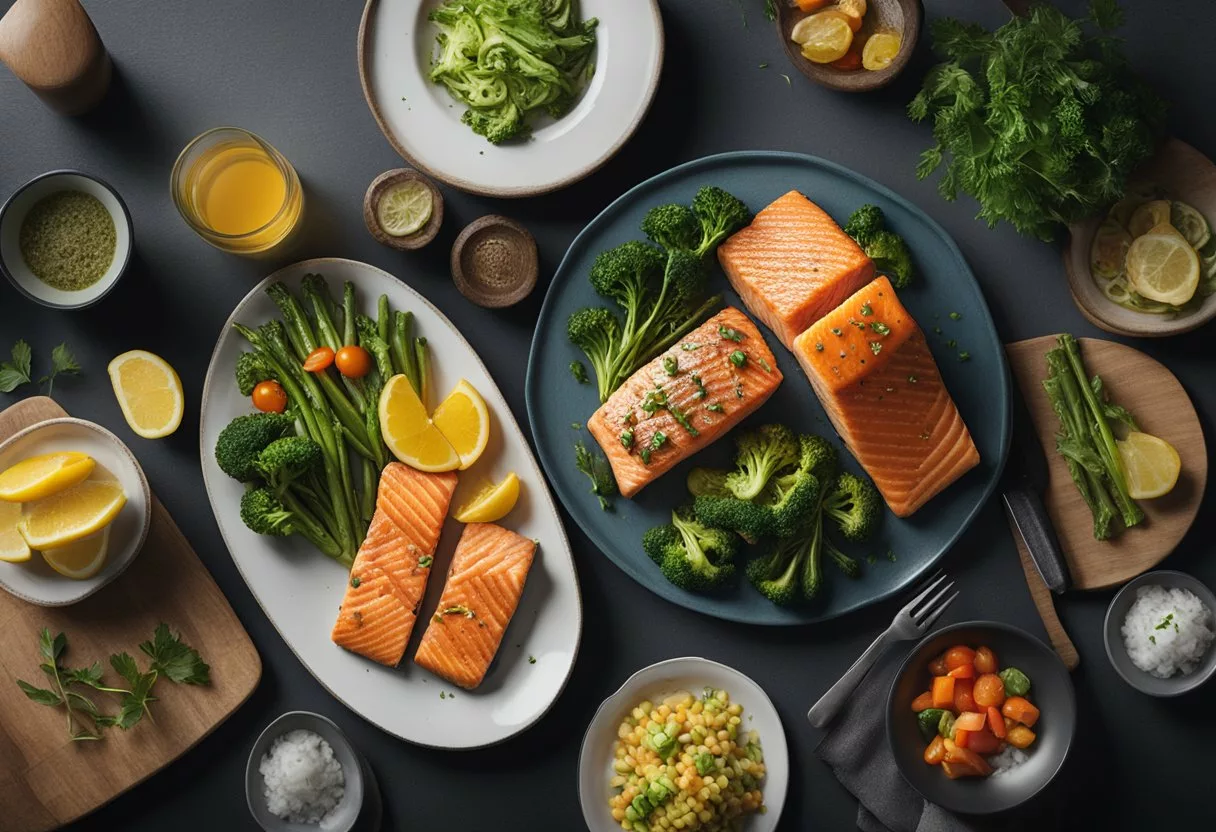
When incorporating seafood into a diabetes diet, it’s important to consider mercury levels, portion sizes, and preparation methods. Ensuring that seafood consumption complements a balanced diet is key for managing diabetes effectively.
Understanding Mercury Levels
Seafood is a nutritious choice, offering omega-3 fatty acids which are important for heart health. However, mercury can be a concern in some fish species.
The FDA provides guidelines on fish consumption, especially for those with health concerns like diabetes.
Fish like salmon, mackerel, trout, and sardines are often recommended for their lower mercury content and high omega-3 levels, enhancing their nutritional profile for those with diabetes.
Managing Portion Sizes
Portion control is vital in a diabetes diet to manage blood sugar levels and ensure overall nutritional balance.
Seafood can be included in the diet in moderation, with attention to portion sizes to maintain satiety without excessive calorie intake. A standard portion size is about 3-4 ounces, roughly the size of a deck of cards.
Preparation Method Matters
How seafood is prepared significantly affects its health benefits.
Grilling, baking, or broiling are healthful preparation methods that do not add extra saturated fats.
Seafood should be cooked using methods that preserve its healthy fats without introducing high levels of calories or unhealthy fats. Avoiding heavy sauces and batters can also help maintain the nutritional integrity of the seafood.
Incorporating Seafood in a Balanced Diet
Seafood should be part of a balanced diet that includes a variety of nutrients.
When integrating seafood into a meal, it should be paired with foods low in carbohydrates and high in fiber to maintain a stable blood sugar level.
It can contribute to the overall nutritional quality of the diabetes diet, providing essential nutrients while maintaining heart health and contributing to disease management goals.
Shellfish and Diabetes
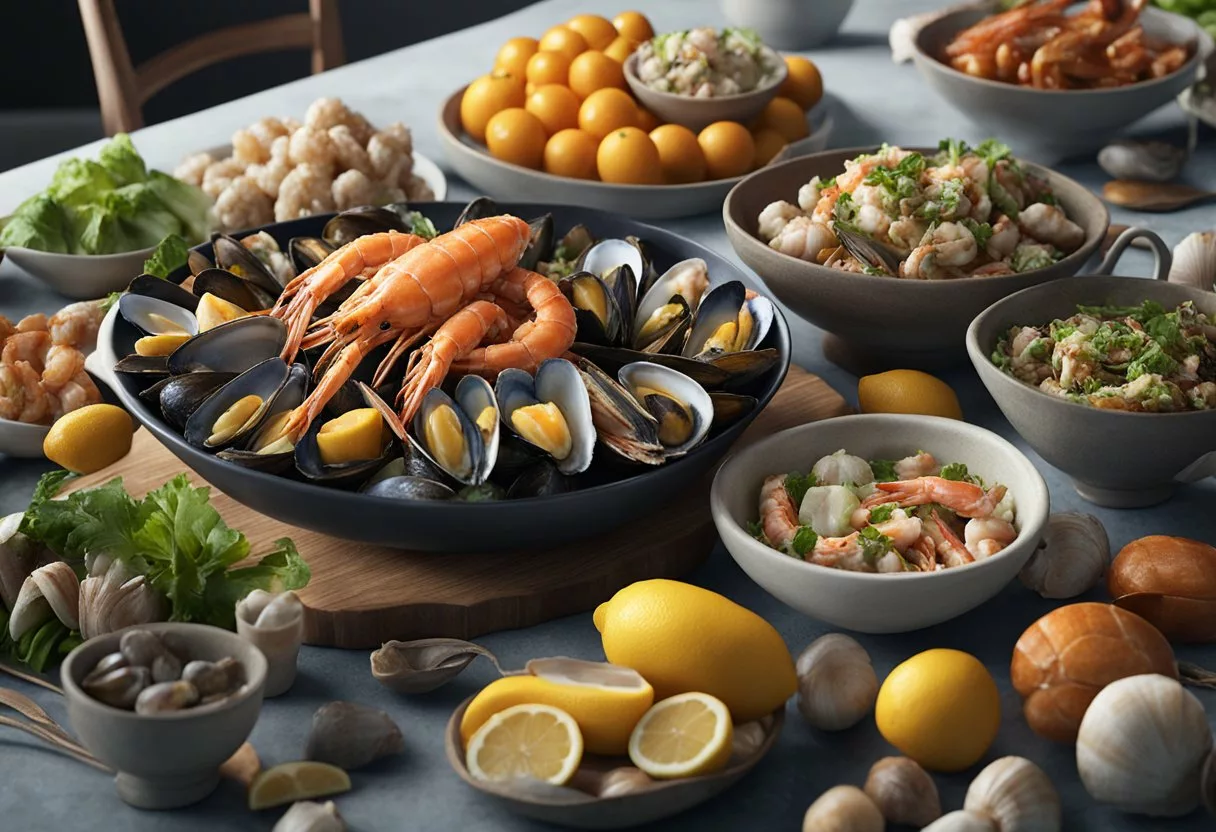
Shellfish are a diverse group of seafood that can be a smart addition to a diabetes-friendly diet due to their high protein content and beneficial minerals and vitamins.
Shrimp: A Popular Choice
Shrimp is one of the most commonly consumed types of shellfish. It is an excellent source of protein and provides important minerals such as selenium and vitamins.
However, shrimp is known to contain higher levels of cholesterol, so it should be eaten in moderation.
Crab: A Flavorful Addition
Crab adds a rich and flavorful option for those managing diabetes. Offered in various forms, such as crab legs or crab cakes, this shellfish is high in protein and low in saturated fat.
Crab is also a good source of vitamins and selenium, a mineral important for maintaining overall health.
Scallops and Clams: Delicate and Nutritious
Scallops and clams offer a delicate texture and are also rich in nutrients beneficial for diabetes.
They provide protein, calcium, and iron. Both scallops and clams contain vitamin C, essential for immune system health. Their nutrient density makes them an excellent choice for adding variety to a diabetes-focused diet.
Creative Seafood Recipes for Diabetics
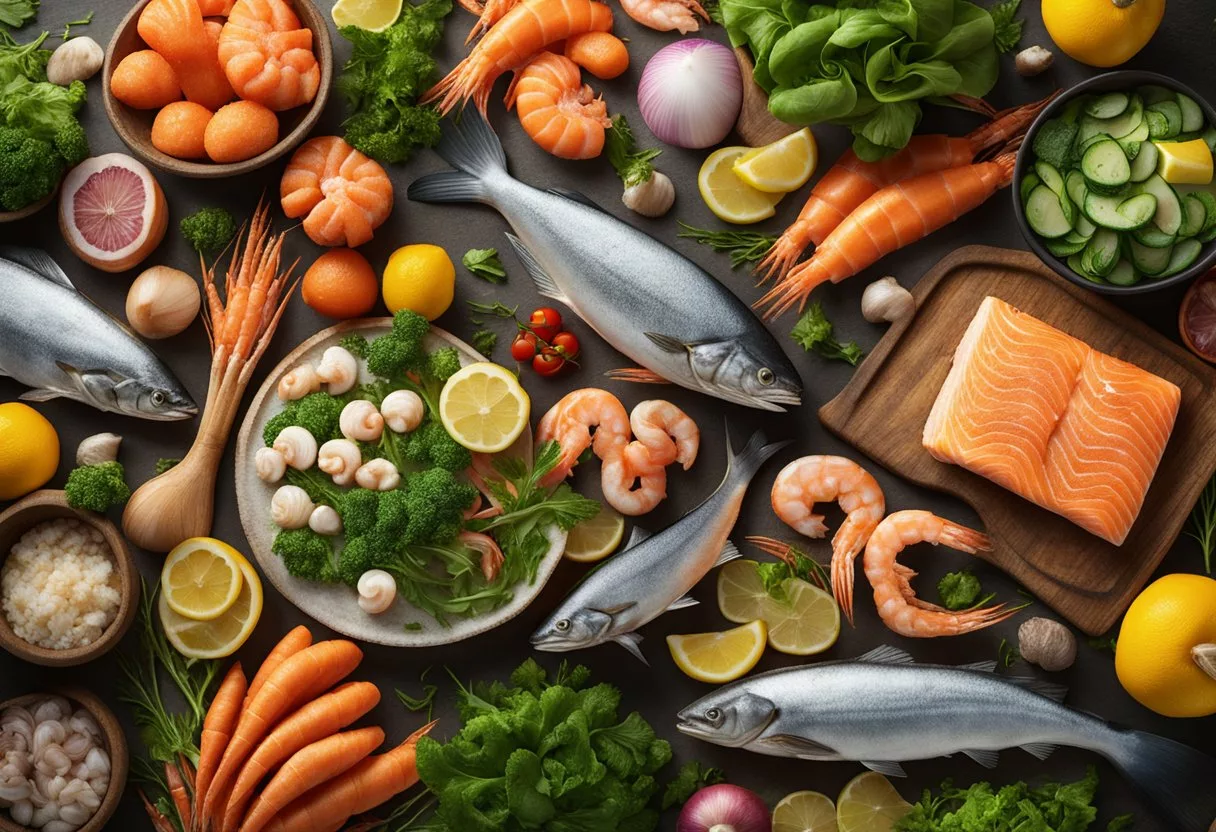
Seafood can offer both variety and nutritional benefits for people with diabetes. It’s important to focus on cooking methods and ingredients that contribute to stable blood sugar levels.
Healthy Ways to Cook Fish
One can prepare fish using methods that preserve its nutritional value while enhancing flavor. Grilling is a superb method that imparts a smoky flavor and requires minimal oil. Meanwhile, baking offers a gentle way to cook fish thoroughly while allowing infusion of flavors from herbs and spices. Both cooking methods support a diabetic diet by minimizing added fats and carbohydrates.
Diabetic-Friendly Seafood Meals
A standout dish for those managing diabetes is the Cilantro Lime Shrimp, which marries zesty flavors without added sugars. Similarly, Fish Tacos can be made diabetic-friendly by using whole grain tortillas and fresh salsa. Tuna salad, with substitutions like Greek yogurt for mayonnaise, turns a classic into a healthier option.
Tips for Flavorful and Healthy Seasonings
Seasonings play a significant role in making seafood dishes delectable without compromising health. A combination of ingredients such as olive oil, pepper, and fresh herbs can deliver taste without additional sodium or sugar. For a diabetic-friendly kick, spices like garlic, paprika, and chili are ideal for enhancing the natural flavors of seafood.
Sides and Pairings for Seafood
Complement seafood with sides that round out the meal while being mindful of a diabetic diet. Salad and steamed vegetables provide fiber and essential nutrients without excessive carbohydrates. Meanwhile, brown rice or whole grain pasta are great options for adding a wholesome grain to the meal.
Resources and Guidelines
When selecting seafood that fits within dietary recommendations for diabetes management, it is important to refer to established guidelines from health authorities. These guidelines often revolve around omega-3 fatty acids, mercury content, and the overall balance of nutrition in a diabetes-conscious diet.
American Diabetes Association Recommendations
The American Diabetes Association underscores the importance of including fish high in omega-3 fatty acids for those with diabetes, particularly for heart health. They suggest incorporating fish into meals at least twice a week. Ideal options are those lower in mercury and higher in omega-3s, such as salmon and sardines. Omega-3 fats help reduce inflammation and lower the risk of chronic conditions such as heart disease.
American Heart Association on Seafood
The American Heart Association emphasizes eating fatty fish to reap cardiovascular benefits. They recommend eating two servings of fish (particularly fatty fish) per week for people with Type 2 diabetes. Fatty fish like mackerel and trout provide considerable amounts of omega-3 fatty acids, which are crucial for heart health and overall wellness in individuals managing diabetes.
Harvard School of Public Health Studies
The Harvard School of Public Health has conducted studies showing that seafood can play a role in preventing chronic diseases. These studies highlight that the type of fat found in seafood is associated with a decreased risk of cardiovascular health issues and can be beneficial for those with diabetes. However, they also stress the importance of balancing seafood intake with an awareness of potential mercury exposure.
FDA Guidelines on Seafood Consumption
The FDA provides guidelines on seafood consumption that aim to minimize exposure to mercury while maximizing health benefits, especially for those with diabetes. They suggest a variety of seafood to balance nutrition and health risks. The FDA guidelines include lists of fish that are higher and lower in mercury, advising the consumption of lower mercury fish such as tilapia, cod, and catfish. They recommend eating 8 to 12 ounces of these kinds of seafood per week.
Frequently Asked Questions
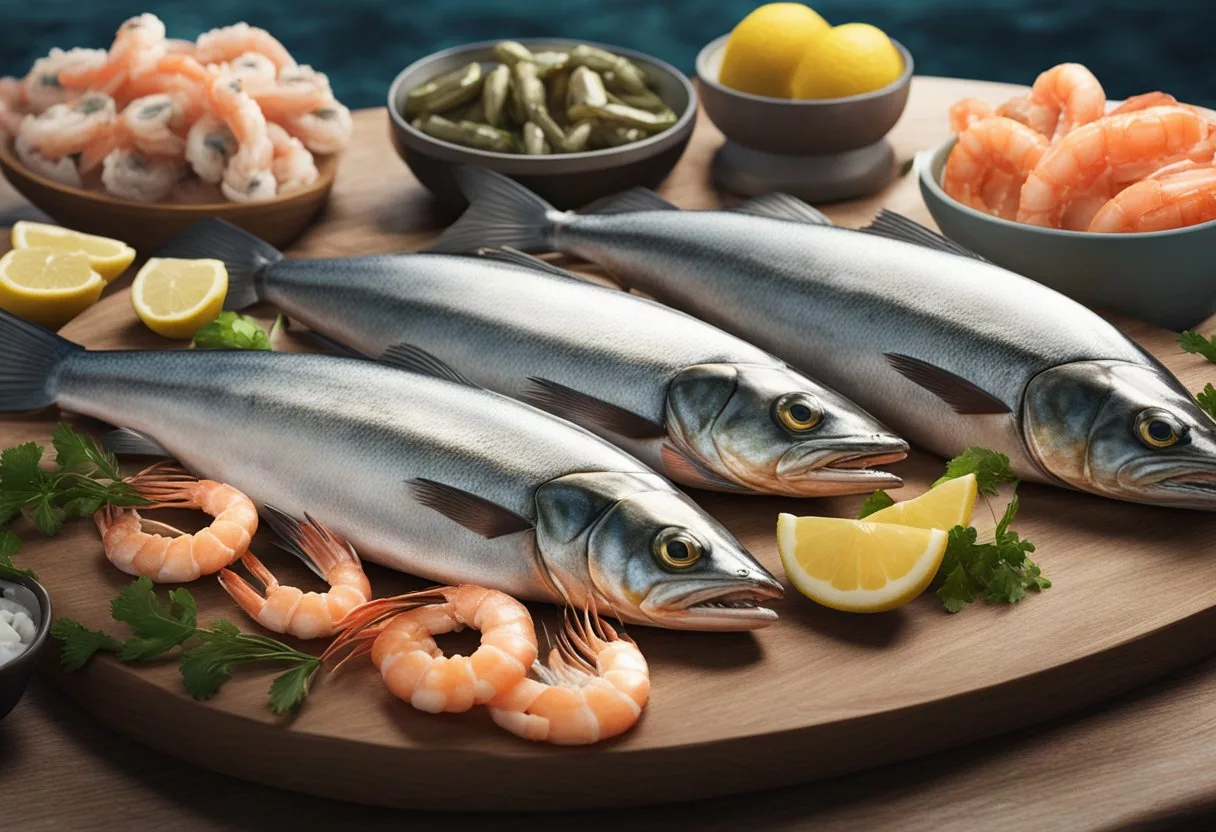
The best seafood choices for those managing diabetes are high in omega-3 fatty acids, low in unhealthy fats, and provide essential nutrients without raising blood sugar levels.
What types of fish are best suited for a diabetic diet?
Individuals with diabetes are encouraged to focus on fatty fish like salmon, mackerel, trout, and sardines due to their high content of omega-3 fatty acids, which support heart health.
Are there any benefits of including shellfish in a diabetes meal plan?
Shellfish such as shrimp can be a nutritious part of a diabetes diet, offering significant amounts of protein with very low carbohydrates. They should, however, be consumed in moderation due to their cholesterol content.
Can eating sardines regularly benefit blood sugar control in diabetes?
Including sardines in one’s diet can be beneficial for blood sugar control due to their high omega-3 fatty acid content, which is known to have a stabilizing effect on blood sugar levels.
Are there any types of seafood diabetics should avoid due to high blood sugar risks?
Diabetics should limit intake of breaded or fried fish and those high in mercury like shark, as these can pose health risks and potentially impact blood sugar control negatively.
How does the preparation of fish affect its suitability for a diabetic diet?
The preparation of fish greatly affects its health benefits; grilled, baked, or steamed fish is preferable over fried options which can add unhealthy fats and calories, undermining the management of diabetes.
Is there a difference in the impact of fresh versus canned seafood on diabetes management?
Fresh and canned seafood can both be suitable for diabetes management. However, canned options must be low in sodium and free from added sugars or unhealthy fats.

